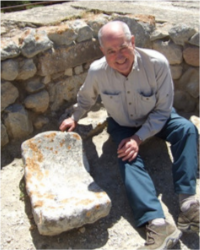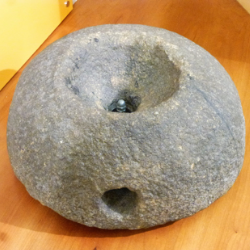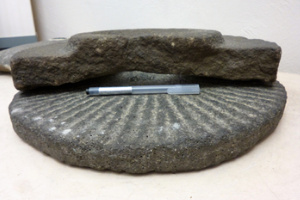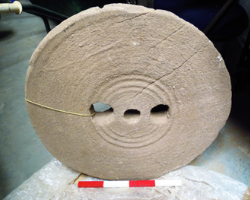YORKSHIRE QUERN SURVEY
What Do We Do?
- We study prehistoric, Roman and early medieval equipment used for grinding flour and other materials.
- Our paper archive covers over 9,000 hand-querns and over 600 millstones, making it one of the largest data banks in the country.
- This resource provides the basis for publications researching developments in quern usage, with a focus on the north of England.
- We respond to queries from individuals or from local groups about querns & millstones.
- We work with commercial archaeological units, providing either a) summary assessments or b) more detailed quern reports for publication.
How Have We Progressed?
- Mortimer Wheeler, in 1954, only knew of 13 beehive querns from Yorkshire, which he saw as evidence of a ‘crude, pastoral, semi-nomadic economy’.
- Between 1955-66, Sidney Jackson and his volunteers at the Cartwright Hall Museum, Bradford collected information on over 300 querns from West Yorkshire.
- In 1980, Raymond Hayes, John Hemingway & Don Spratt collected data on 120 beehive querns from NE Yorks, demonstrating a widespread adoption of a mixed farming regime in the area around the N. York Moors during later prehistory and the Roman period.
- During the 1980’s, Don Spratt built up a team of c.20 YAS members of the Prehistory Research Section, who reported on local quern collections throughout Yorkshire. By his death in 1991, his Yorkshire Quern Survey (“YQS”) archive included data on ca.1,000 querns.
- David Heslop continued collecting quern data throughout the 1990’s. In 2008 he published his YAS Monograph on 562 beehive querns from N Yorks and S Durham, setting new standards for quern analysis.
- Active work on the YQS archive resumed in 2002, when John Cruse was appointed YQS Quern Co-ordinator.
- Since then, the scope of the Survey has been extended. Its research programme investigates the typology, chronology and distribution of the whole range of hand-querns and mechanically-powered millstones from early prehistory to the early medieval period.
- At the time of writing in 2024, our paper archive includes information on over 9,000 querns and over 600 millstones, making it one of the largest data banks in the country.
- Our main regional focus is on the development of querns in the area between the Mersey-Humber up to Hadrian’s Wall.
What Are Our Current Activities?
- An annual YQS Newsletter is circulated to YAHS–PRS members to update them about on-going projects and any reports which were published during the year.
- Outreach Activities: Until disrupted by Covid, the Co-ordinator gave 44 talks to over 1,600 people. We still respond to general enquiries from individuals about their querns, as well as to requests for specialist assistance – since 2022, we’ve handled 35 queries on 67 stones.
- Assistance to Commercial Archaeological Units: Reports have been provided to over 30 units, ranging from summary assessments for small evaluations, to full site analysis for eventual publication, covering over 500 querns over the last 20 years. Funds raised by this work have been recycled to fund Prehistory Research Section projects and awards.
What Are The Main Types of Grinding Equipment?
1. Saddle Querns

- Split boulder set in ground: Typically 35 (+/-10) cm long, 20(+/-5) cm wide and 12 (+/-5) cm thick:
- Used with an upper stone to grind in a circular, or with a back-and-forth motion;
- Used from 3,800BC into the Roman period.
2. Beehive Rotary Querns

- Typically 30 (+/-3) cm diameter and 17 (+/-7) cm high:
- Easier to operate, as the weight of the rotating upper stone replaced the human downward pressure on a saddle quern, crushing the grain against an earth-set lower stone;
- Regional preferences in quern profile and stone type.
- Used by ‘native’ population from later prehistory into Roman times (200/100BC – 300+AD).
3. Roman Disc Hand Querns

- More compact design, typically 45(+/-5 ) cm diameter, 8 (+/-4) cm thick:
- Initially German lava querns were imported by the Roman military
- Several regional variants were then made in local stone.
- The lower stone usually has a flat base, with a central opening for the spindle.
- Used by soldiers, elite households and the ‘Romanised’ population throughout Roman period
4. Mechanically-Powered Millstones

- Greater than 50-55cm diameter. Sometimes the upper stones have complex, central perforations. Lower stones are also perforated, for the drive-shaft to rotate the upper stone.
- The upper stone was powered by humans, by animals or by a water-wheel
- Several different designs have been recognised.
- Introduced in in the late 1st century AD, being in common use by the third century AD.
Where Can I Learn More About Querns?
- General: Peacock D: 2013: The Stone Of Life: Querns, Mills and Flour Production in Europe up to c.AD 500, Highfield Press.
- Saddle Querns: Cruse J, 2017, Sizing up Neolithic Saddle Querns’, in Shaffrey R (ed.), p128-147, Written in Stone: papers on the function, form and provenancing of prehistoric stone objects in memory of Fiona Roe’, The Highfield Press.
- Beehives: Heslop D: 2008: Patterns of Quern Production, Acquisition and Deposition: A Corpus of Beehive Querns from N. Yorkshire and S. Durham, YAS Occ. Paper No 5, Leeds.
- Lava Querns: Banfield L, 2023, Making Flour the German Way: Distribution, use and deposition of imported lava quernstones and millstones, BAR Brit.Ser. 681, Oxford.
- Wattle Syke, Wetherby: site report: RJ Cruse & D Heslop, with G Gaunt: 2013: Querns, Millstones and Other Stone Artefacts’ in L Martin, J Richardson & I Roberts, IA & Roman Settlement at Wattle Syke: Archaeological Investigations during the A1 Bramham to Wetherby Upgrading Scheme, WYAS, p165-183.
- Scotch Corner, A1: site report: Cruse J, 2020, The Querns, 531-544, in Fell, D. W. (2020). Contact, Concord and Conquest: Britons and Romans at Scotch Corner. NAA Monograph Series 5. Barnard Castle: Northern Archaeological Associates. [available free at https://doi.org/10.5284/1078330 ].
- Catterick Vicus: site report: Cruse J, 2021, Querns and Millstones, 555-583, in Ross, S. and Ross, C. (2021). Cataractonium: Establishment, Consolidation and Retreat. NAA Monograph Series 6. Barnard Castle: Northern Archaeological Associates. [available free at https://doi.org/10.5284/1078331 ].
Contact:
John Cruse: YQS Quern Coordinator: john.cruse1@btinternet.com
Last updated 18.11.24